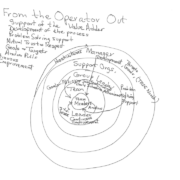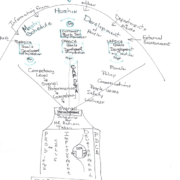The Role of HR in a Continuous Improvement Organization: Supporting Enlightened Leadership
(Reposted by permission of the author from LinkedIn)
In recent articles we have been talking exclusively about HR and its role in the process of achieving great things. Now we are going to shift gears slightly. In the ideal situation HR and leadership work together in overcoming the power of inertia and achieving the long, mid and short-term goals of the organization. I will show how HR supports and how leadership enacts and together, creating the way forward to greater performance. In truth, it is the work of both that allows an organization, through its leaders, to be enlightened.
Enlightenment is a condition that can only be defined in terms of the organization. In our work enlightenment is a condition that allows the organization to satisfy its customers, improve its business situation and enable those who follow to also achieve success. In short, in any organization, its leaders enable those in the organization to be enlightened causing the organization to improve. Enlightenment is a shifting perspective that creates the future of success. It is a constant, continuing effort that takes on the status quo and leads the organization to higher levels of performance. It is not a philosophic endeavor but a disciplined practice for all those in the organization.
Leadership is the key. They have two elements to their “true north”: performance that meets their customer’s expectations and development of those who make it happen. Leaders are guided by a few simple principles that must be tightly held and consistently performed:
- Leaders are faithful to their duties for the continuous improvement of the organization
- Leaders are studious and creative in their approach to improvement
- Leaders recognize that those who add value are the most important and insist that all actions are practical to them
- Leaders create a homelike atmosphere that is warm and friendly
- Leaders respect order that is reverent
- Leaders have a firmly held belief that everyone can learn and grow
If we were to measure enlightenment, we would find four key aggregates that determine their overall success
Leaders exhibit the behaviors of Character
- They know the aim is to have a good life in a classic sense
- They know their definition of issues is a key to achieving character
- They challenge other to achieve a better life by overcoming the status quo
- They live their life to demonstrate how discipline is a critical element to achieve
Leaders exhibit the behaviors of Competence
- They accept that behavior demonstrates their ability to lead
- They know performance follow competent behavior
- They know the processes that support performance
- They know that behavior is key only when it involves others
- They use critical thinking in the solution of all problems, policies and process
- They accept the management accountability for the process
Leaders Collaborate
- They recognize the necessity of engaging everyone in a meaningful way
- They create a non-blaming environment for the problem-solving process
- They look at the problems as opportunities
- They listen with enthusiasm to find a diversity of ideas
Leaders have Courage
- They are willing to take risks & allow their people to take risks
- They can see a better condition even when others do not
- They promote the aggressive response to problems to encourage problem solving
- They think systematically to integrate issues
- They use mistakes for learning
- They insist on commitment to action
- They help others achieve self-reliance and accountability
There is a pattern that leaders follow. This pattern is both a management practice and problem solving process. It follows the basic logic of critical thinking. It is based on using facts instead of opinion. The process is also repeated over and over when a problem is found until the root cause is found. If you combine that notion with problems are good you will not see the situation where things are tried once and if not perfect in its output, forgotten. You see all action taken as learning with the objective of persistence until the problem is solved at the root cause. For the problem solver this puts forth the confidence to persist. The inertia of the status quo will be overcome and progress persists. It is the leader’s responsibility to develop the organization into good critical thinkers who accept problem solving as a continuous endeavor and continuous improvement as the outcome of the same pattern of thinking.
The pattern is called CAPDCA (Check, adjust, plan, do, check and adjust) for a simplistic view of the discipline. It is a way to solve problems and also is the same pattern used for good management. To understand how this simple process becomes enlightenment, you must understand how a pattern of predictable behaviors and discipline become a culture of performance.
The first step is to “Grasp the situation” (check). It requires a wide view of the organization to be able to see what is possible. It has encased in its aims a sense of gratitude for the opportunity to guide and direct the organization. Grasping requires knowledge of the business. It necessitates going and seeing the actual people, the actual situation and the actual problems to be solved as a system. It requires the ability to interact with all those involved in a productive attitude of mutual trust and respect. In the conclusion, grasping requires the ability to assimilate large amount of information from the process, the internal environment and the external environment to form a critical view of what is needed to achieve the system’s goals and targets. The key is to use this pattern consistently to create predictability and trust in the organization. This trust enables the subordinates to take a prudent personal risk based on their continuing experience to solve problems.
The objective is to create a way forward that is based on the experience of those performing the work of the organization. It has a foundation of fact from the actual situation, trust from being heard and predictable engagement by the leader. It leads directly to the setting of the way forward by the leader. Smart leaders always know that, as complex as this can be, it must be put into the words of those who perform work. This is called setting direction. It is a necessary ingredient of the next phase of delegation of the planning process to achieve the organization described in the way forward by the leader. The key to this step is defining “what” is the expectation for the future. Those being delegated to must define “how” this happens. The “how is in the form of a plan. For the enlightened leader every plan must meet the requirement of being achievable, properly resourced and realistic to be achieved. For the leader, as they review and discuss these plans, the development of the individual is presented. This allows the leader to give focus to development of the individual. The proper perspective for the leader is to stretch the individual to require they learn new not know issues, but not so much to cause them to fail.
Monitor the Outcomes
This agreed to plan becomes the expectation of the leader and the commitment of the subordinate. It is monitored by the leader to find any deviations that can be used for learning and development. This requires the leader to go to the “place of execution” on a regular basis and review the actual situation. At this point both the leader and subordinate are in the performing phase of the PDCA cycle (Do and Check).
Care must be taken to not take away the commitment of the subordinate. The going and seeing is a time to both progress the targets and to encourage the subordinate to achieve the growth that is expected. Being able to find deviations is not a gotcha exercise but a good time for questioning for understanding and development for the subordinate. Perhaps the most important competency for the leader is to form questions the are open ended enough to prod thinking but not to indicate the correct answer; to teach critical thinking.
On a regular basis the leader must conduct formal reviews with all their direct subordinates to achieve two purposes:
- Find the status of execution
- Create mutual learning and support of each other by their peers. The intention is to have the subordinates model like sessions with their subordinates.
True monitoring is a team effort. Everyone performs to their accountability and the leaders demonstrate how it is done. This creates a sense of purposefulness that allow the organization to utilize a process that is usually contentious. HR is a monitor of this process. HR has as its objective to ensure that everyone is treated with mutual trust and respect, that the organization is actually developing in its behavior resulting in the resolution of issues of disagreement. These issues being resolved causes the individual to develop. It is best served with a no blame intention which allows the problem to be the focus, not the individual.
HR accomplishes it’s objectives by seeing the actual situation to understand if appropriate behavior is being used and coach those involved to more productive interaction. One reality of a production environment is that the customer must be served and deviations from this basic expectation must be resolved quickly. HR promotes personal accountability in its policy, operating principles and its interaction with employees. HR uses the PDCA process to work problems and find solutions that allow the organization to grow and develop. To accomplish this, HR must assume the role of a leader and accurately grasp the situation, set the way forward and delegate the expectation of behavior development is being met. HR on the shop floor relies not just on their own wits but on the collective knowledge of all relevant HR section of safety, personnel and Training and Development to achieve the best system-wide solutions to deviation from expectations.
HR also promotes the positive side of organizational growth by creating processes for suggestions, team environments and growing understanding of the PDCA process. Each of these and HR will also follow the same pattern as the leader and their subordinates in the course of their responsibilities. This demonstrates the validity of PDCA as it is embraced by all elements of the organization.
For HR and the leader, the described processes are sustained by consistent behaviors. First each must be willing to serve others and not thwart the development of individuals and the entire organization. All the activities are aimed at enhancing individuals and teams with a focus on an organization for learning and growth fueled by intense interest in getting better. All of this generates an organization that is grateful for the ability to grow together.
In this type of organization, you find that there is an open mindedness, open and honest discussion about surfaced conflicts, a healthy skepticism about ideas that alter the system and a striving for consensus. Consensus does not mean total agreement. It means support until the idea is proven to be successful or not usually with a short-term review date.
The idea of enlightenment is complex, requiring a whole series of activities to be accomplished to achieve a better workplace. It is facilitated by the pattern of PDCA and verified when mutual trust and respect is followed. The outcomes are not the aim. The process is. By managing the processes, the outcomes are most likely to be achieved. If they are not, the process reacts to highlight that the problem still exists and the process of problem solving must be repeated to find the answer. All with a recognition that learning still needs to be done.


 2019, Total Systems Development, Inc.
2019, Total Systems Development, Inc.
 2019, Total Systems Development, Inc.
2019, Total Systems Development, Inc.



